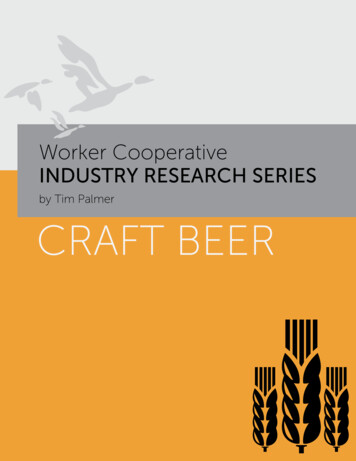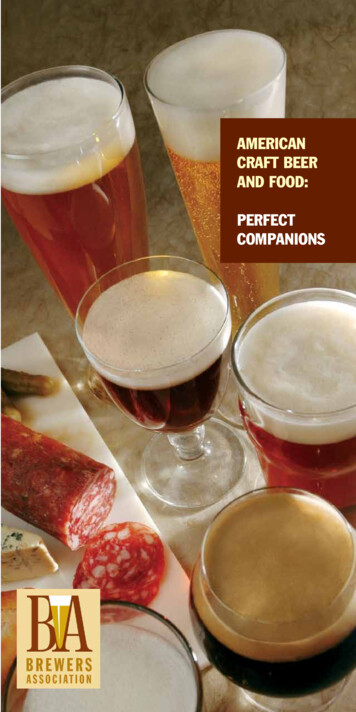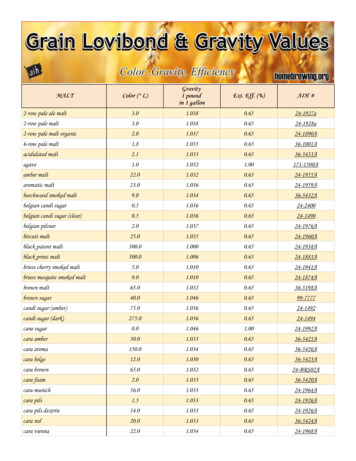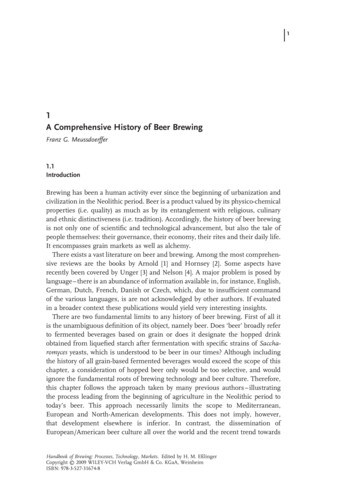
Transcription
Worker CooperativeINDUSTRY RESEARCH SERIESby Tim PalmerCRAFT BEER
INDUSTRY RESEARCH SERIESExecutive SummaryThe craft brewing industry presents an interesting possible route to scale forworker cooperative development. The industry, incredibly, is still growing aftermore than two decades of upward trends. Moreover, the independent andartisan workplace culture fostered by owners and workers alike has madesome firms more receptive to employee ownership. The success of Black StarBrewery and Pub Co-Op, as well as the ESOP-owned New Belgium BrewingCompany provide models for replication and education. Worker cooperativedeveloper participation in this industry has been minimal to date, though asustained focus here could make an important impact.Opportunities: High growth industryEmerging employee ownership trend could promote conversionsCoop difference can improve compensation, especially in brewpubsExisting model for democratic management being replicatedConsumer member capital available for start-up costsPotential rural development strategyChallenges: High start-up costs and/or longer timeline to profitabilityLarger craft brewery competitionLow worker cooperative developer experienceComplexity of tax and regulatory structureIndustry Snapshot Industry Size, Market and Future TrendsBeer production and sales in the US is a massive 28 billion/year industry but is dominated by fourlarge manufacturers that account for close to 90% of the national market. However, consumers havebeen trending toward craft brews. Craft breweries include both stand-alone production facilities, aswell as brewpubs with an attached bar/restaurant. Microbreweries ( 15,000 barrels/year), brewpubs(25% beer sold on site) and regional breweries ( 6 million barrels/year) are the dynamic players inthis market. In 2014, craft brewers had reached a record high 19.3% of the US beer market by retailvalue. This was up 22% over the previous year. Craft breweries now employ over 115,000 people in theUS, up 5,000 from 20131. This high growth in employment has persisted in the industry for most of the2000s. Revenue in the brewing industry is expected to grow at a compounded rate of 4% between2015 and 20192. Moreover, craft breweries will likely drive this growth as their market share is expectedto exceed 15% of the industry by 20203. Still, some predict that there will be more brewery closings astoo many new start-ups are entering the market. Intra-craft beer competition may become a moreimportant part of the market dynamic than the general split with the four US large breweries, thoughrecent small brewery acquisitions by the big breweries also are having an impact4.1
CRAFT BREW INDUSTRY ProfitabilityNational estimates of average net profit margins range from 5-6%5 to more than 12%6 . However,margins may be somewhat higher for craft breweries as industry giant SABMIller reported a margin ofonly 3% in 20147. Boston Beer Company (the largest craft brewer) reported a profit margin of 8.76%in the latest quarter8. Black Star Pub and Brewery Co-Op’s 2013 Annual Report show a margin in linewith these figures (6.3%). Supply Chains and DistributionCraft breweries typical are middle links in beer’s long supply chain from raw materials to consumption.They rely heavily on the agricultural sector for key ingredients (e.g., barley, hops, yeast) as wellas packaging materials and heavy equipment. As such, they are subject to price risks associatedwith seasonal crops and long-distance transportation costs. They also typical consume very largequantities of water (about 7-12 gallons of water per 1 gallon of beer) and electricity in the brewingprocess. Except for beer sold onsite at brewpubs, most beer is then sold to distributors who in turnbring the final product to retailers. The heavily regulated and taxed three-tier beer distribution systemis a key factor in the growth of craft breweries because distributors function as brand marketers andallow small batch products to reach the same retail shelves as the large beer brands9. Nonetheless,some small start-ups begin as self-distributors to save on costs though this option varies widely bystate law10. Start-Up and Operational CostsBrewing is capital-intensive, averaging 900,000/worker in annual revenue11. Microbreweries typicallyachieve less than one-tenth of this ratio, however due to lower economies of scale12. Break-evenprofitability ranges from 3,000 to 15,000 annual barrels. Start-up costs for nanobreweries can be aslow as 50,000, while new microbreweries have a minimum of 100,000 - 500,000 in start-up costsbased on annual barrel production13. Bars and restaurants can cost an additional 250,000 - 2 millionbased on size and amenities14. Yet craft brewing is also a fairly labor-intensive process. In Oregon forexample, more than 75% of industry employment is in brewpubs, thus keeping wages generally in linewith the low-paying restaurant industry15. Nationally the Bureau of Labor Statistics reported a weeklyaverage pay of 1,041 in the 3rd quarter of 2014 in all breweries. However this includes all occupationsand hides the unequal distribution of pay between lower and higher skilled workers. WorkforceMost jobs in brewing are entry-level, requiring only a moderate level of on-the-job training, especiallyin the larger workforce involved in brewpub operations rather than direct manufacturing. Trainingfor servers, bussers, hosts, dishwashers and cooks typically does not vary much from other foodservice establishments. On the brewing side of operations, however, occupations range from brewers,assistant brewers and cellar operators to warehousing and logistics. The craft brewing positionsoften require specialized training over several months prior to employment and some internshipsand apprenticeships are available16. Managerial positions in operations or production (as opposedto restaurant/taproom managers) often require both a bachelor’s degree and a moderate level ofindustry experience. Public Policy FactorsAll breweries pay a federal excise tax per barrel of beer produced. The standard rate is 18/barrel,though for small breweries’ first 60,000 barrels are taxed at a rate of 7/barrel. States also chargetheir own excise taxes that vary widely. The US median is 0.20/gallon, but certain states are morefavorable17. There also is wide variance by state in the degree to which they allow self-distribution.While some allow for unlimited self-distribution, others require licenses and put in place annual2
INDUSTRY RESEARCH SERIESvolume limits. Lastly, the Alcohol and Tobacco Tax and Trade Bureau (TTB) oversees both licensingand taxation of breweries according to a complex set of regulations. Knowledge and compliance withthese rules is crucial to successful craft brew operations. Changes to brewing law and policies mayoccur in the near future as the Brewers Association continues to lobby for changes that could reduceadministrative and tax burdens (e.g., the Small Brew Act) and/or level the competition with the largebreweries.Cooperative Potential Snapshot Existing Cooperatives & Worker Owned FirmsThere has been growing interest in both cooperatives and ESOPs in the brewing industry in the pastseveral years. ESOPs in particular have gathered a great deal of attention, as a fair amount of craftbrewers have converted to that form of employee ownership beginning in the 1990s but ramping upin the last four years. New Belgium Brewing is the largest (about 500 employees) and most notableESOP, having completed its transition to 100% employee ownership in 2012. At least 10 other breweryESOPs exist, employing roughly another 1,000 employees. However, this includes the 70 employees ofFull Sail Brewing, which voted in March 2015 to sell out to a private equity firm18.On the cooperative side, there are at least 7 operational brewing cooperatives dispersed randomlyacross the country. Of these, 2 are worker cooperatives, 2 are consumer-worker hybrids (or consumercoops with staff collectives) and the remaining 3 are consumer only cooperatives. However, thesuccess of these cooperatives has inspired a much larger number of planned cooperative brewingstart-ups that are at various stages of development. Altogether 16 new brewing cooperatives areplanned for opening in 2015. Many of these are consumer only in focus, though at least three planto build consumer-worker hybrids. Black Star Brewing in Austin, TX, is directly cited by many of thesenew entrepreneurs as the inspiration for their models and in some cases has directly consulted ontheir business development.There is no one area of the country where brewery cooperatives or ESOPs are located, though theyhave tended to form where craft brewing is already strong, such as Colorado, the Pacific Northwestand the upper Midwest, as can be seen on the table below.3
CRAFT BREW INDUSTRYNameSan Jose Brewery and Pub*Veneration Brewery Co-opLocationSan JoseDenverWorkforceCACOTwin Pints Co-op*High Five Co-op BreweryFair State Brewing CooperativeBurlington Beer Works Co-opTuckaseegee Brewing CooperativeLos Alamos Beer Co-opFifth Street BrewpubMiami-Erie Brewing Co-opPhiladelphia Cooperative Brewery Inc.Blue Tick BreweryBlack Star Co-op Pub and Brewery**Fourth Tap Brewing Co-opYellow City Co-op Brewpub*Full Barrel Cooperative TaproomFlying Bike Cooperative BreweryBellingham Beer LeagueRiverwest Public House Cooperative**Artisan Beverage Cooperative**Seven Bridges Cooperative**Blue Nose Gopher Brewery Cooperative50Brew80East LansingGrand RapidsMinneapolisBurlingtonJackson CountyLos reenfieldSanta CruzGranite NCO* startup worker cooperative/democratic workplace** operational worker cooperative Existing Worker Cooperative DevelopersCooperation Texas has specific experience assisting brewing cooperatives, having provided sometechnical assistance and guidance to Black Star Pub and Brewery in Austin in its early years. Buildingon this work, they are now in the process of helping to develop 4th Tap Brewing Co-op, whichis tentatively set to launch as a worker cooperative in 2015. Additionally, some of the brewingcooperatives without a worker focus may be receiving assistance from developers. For example, thePhiladelphia Area Cooperative Alliance (PACA) is promoting the Brewers’ Co-op of Philadelphia, acooperative concept with a consumer-producer ownership structure.However, it appears that many brewery coops have formed or are forming without significantdeveloper assistance. Part of the reason for low levels of worker cooperative developer involvementmay be due to location; some of the proposed start-up cooperatives are located in areas whereworker cooperative developers do not have a sizeable presence (e.g., MN, MI). Regardless of thereasons though, this relative lack of developer involvement to date is potentially a mixed signal for4
INDUSTRY RESEARCH SERIESfuture growth. On one hand, it may constrain growth in the industry as developers expend theirlimited resources elsewhere. On the other hand, if many of the start-up cooperatives in the pipelinenow successfully launch in 2015 or 2016 it could indicate that the market for worker ownership in theindustry can be robust without clear development-by-design elements. Potential PartnersLike cooperatives developers, it does not appear that community non-profits or other partners havetaken an interest in this industry. There may some potential for future connections, however, with ruraleconomic developers that view small town breweries as catalysts for jobs and economic activity.While no current connections exist between cooperatives and unions in brewing, the industry may bean interesting area in which to pursue a union-coop model. Historically a bastion of labor strength,the industry’s turn to craft brewing has been a factor in the decline of union density. The four majorunions in brewing (UFCW, IAM, IBT and UAW) have made little headway outside the big four US beermanufacturers. Unions’ desire to combat their eroding influence in this industry may make them moreamenable to alternative strategies, such as partnering with cooperatives. UFCW’s experience withemployee ownership might make it the most logical choice for such prospects. Compensation, Wealth-Building and Industry Standards ImpactThe low wages in the brewpub section of the workforce (coupled with healthy industry profit marginsand growth potential) create the space for worker cooperatives to raise standards directly for thelowest skilled brewery workers. To some degree, Black Star Brewing offers an example of this alreadyoccurring. Black Star instituted a no tipping policy in 2011 and instead offered higher across-theboard wages to reduce the well-known inequities between the front and the back of the house inthe restaurant industry. The Austin brewpub’s wage and compensation policies earned them HighRoad Employer status in the Restaurant Opportunities Center’s Notional Diner’s Guide to EthicalEating in 2013 and 201419. The coop has set its minimum wage at 12/hour, increasing to 13.50 afterthree months. Both figures are well above national averages for servers even when tips are included.Employees also have access to health insurance benefits, retirement accounts and 3 ½ weeks paidleave/year, which are all benefits not universally available throughout the restaurant industry20. Workforce Demographics – Current and PotentialThe current US brewery workforce is mostly white and male. Women comprise about ¼ of allworkers in the industry and people of color are roughly 30%21. However, these numbers includeboth the production and service sides of the industry. If available, employee demographics solely inbrewpub operations might likely resemble the restaurant industry more, which has over 50% femaleemployment and close to 45% non-white employment. Worker cooperatives that could bridge thedivide between the two general groups of workers in the industry have the potential to both buildmore wealth for workers over their lifetime and reduce inequality across racial and gender lines. Bypromoting career ladders and cross training within their organizations, worker cooperative breweriescould begin to tackle this issue in deeper ways than the conventional craft brewing industry. Workplace Culture & Potential for Democratic ManagementBesides the differences between beer production and brewpub operation workers generally, theculture of breweries mirrors restaurants in that kitchen staff and floor staff often work in separateteams which interact sporadically. Administrative, professional and finance staff often form yet anothergroup that can be physically separated from other workers. As such, the potential for demographicmanagement in this industry relies on creating governance forms that both promote regularcooperative decision-making within specified teams and at the same time can bring those teamstogether to make larger choices together when needed.5
CRAFT BREW INDUSTRYAs it has with industry standards, the Black Star Co-Op Pub and Brewery again provides a possiblemodel for how worker cooperatives can achieve this aim in brewing. Black Star divides their workforceinto four teams (Beer, Kitchen, Pub and Business) for team-specific operations. They also bring allworker owners together for large universal decisions, such as setting compensation rates, througha Workers’ Assembly. The Assembly in turn sends an elected liaison to the Board of Directors tointersect it with the cooperative’s consumer members and governance.While still relatively new, the Black Star model appears to have attracted the attention of several newstartup brewery cooperatives that may try to duplicate its structure elsewhere. FinancingFor new breweries, the cooperative form can provide a potentially useful alternative source ofstart-up capital. 21 of the 23 brewery cooperatives or new cooperative concepts employ consumermembership as a way of raising funds on the front end. By offering membership ahead of launch,these businesses gather needed capital, build reliable customer bases and take advantage of earlybranding and marketing.However, consumer membership revenue is probably less useful as a source of ongoing revenue asmembership growth plateaus over time in a given location. Renewable membership fees can correctthis problem, but may also have impact on governance structure. Tools and Technical Assistance NeedsIn addition to the common array of technical assistance needs for worker cooperatives (governanceformation, business planning, recruiting, etc.), brewery worker cooperatives may also need specificassistance understanding and navigating beer taxes and federal and state regulations. Additionally,for those seeking initial financing through consumer membership or stock sales, having access toa developer with experience helping to build multi-stakeholder cooperatives and/or alternativefinancing mechanisms could be immensely valuable.Key Considerations for Worker Cooperative Development StartupsAs noted above, the startup costs for new microbreweries can be substantial especially as allcooperative (worker or otherwise) brewery projects to date have included brewpubs in their businessplans. While smaller facilities are possible and perhaps even somewhat popular, nanobreweries cannotturn a profit or hire any meaningful amount of employees without first expanding production levels.As one New York nanobrewery proprietor noted in an interview, his efforts were “really a non-profitarts projects.” Another owner in San Diego put it more soberly (no pun intended), saying, “ It’s got tobe a side job. Producing this low volume of beer wouldn’t support many lifestyles or raising a family.”22What savings can be had from brewing in a garage or similar setting are negated by the minisculerevenue yields. Thus profitable microbreweries must either be launched at a sufficient size initially orbuilt up to that size slowly and patiently over time.However, worker cooperative breweries that finance their launch wholly or partially through the saleof consumer memberships in a multi-stakeholder ownership model can mitigate some of the riskassociated with starting a new business. Below is a sample of the number of consumer membersat existing or prospective brewery cooperatives and an estimate of the additional capital they havebrought to the table.6
INDUSTRY RESEARCH SERIESBreweryCurrent Status Est. Consumer Est. ConsumerMembership MembershipRevenueModel/NotesBlack Star Pub andBrewery Co-OpOperational3,308 496,200Riverwest PublicHouseFifth StreetBrewpubFlying 00 32,000 160,000 337,500One-time fee of 150. Newmemberships brought inroughly 26,000 in 2013. 40 annually/ 200 lifetimePre-launch1,082 162,300Blue Tick BreweryOperational291 25,000 50,000Los Alamos BeerCo-opHigh Five Co-opBreweryPre-launch420 105,000Pre-launch100 15,000Launched with 850consumer membersAlso has sold nearly 300,000 of non-votingpreferred stock to thepublicUsed higher cost lifetimemembership for initiallaunchAlso has class B non-votingequity interest membersAs the notes indicate above, consumer membership can be sold at different levels and costs and nonvoting equity stock also has been used to finance brewery start-up phases. The latter strategy canbe a substantial funding source if marketed correctly (see for example, Flying Bike’s stock sale). Suchsales are often temporary as the cooperative buys back the stock once it is operating stably. Thusthey practically have the same effect as traditional loans except that both initial access to funds andrepayment or buyback terms are usually much more favorable for the organization. ConversionsThe potential for finding existing owners that may wish to convert their businesses to a workercooperative form may be higher in the cra
ESOP, having completed its transition to 100% employee ownership in 2012. At least 10 other brewery ESOPs exist, employing roughly another 1,000 employees. However, this includes the 70 employees of Full Sail Brewing, which vo











